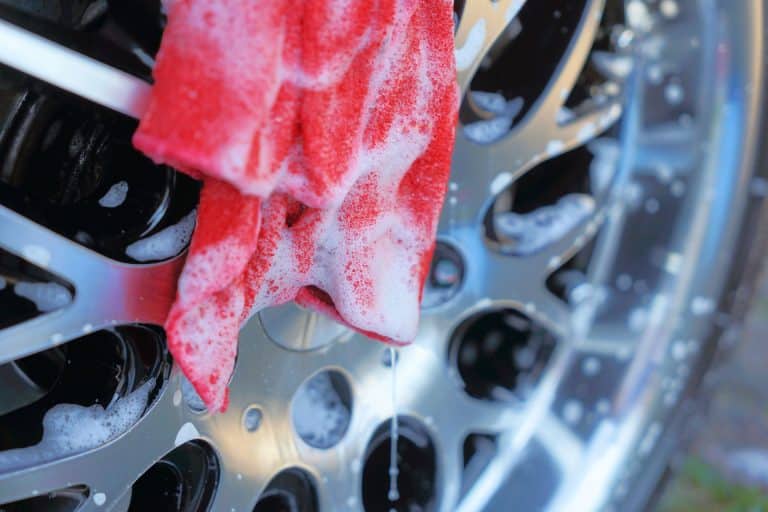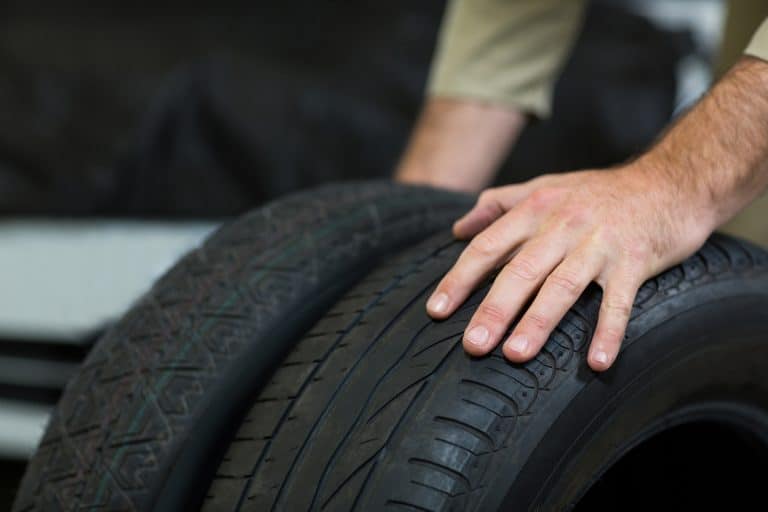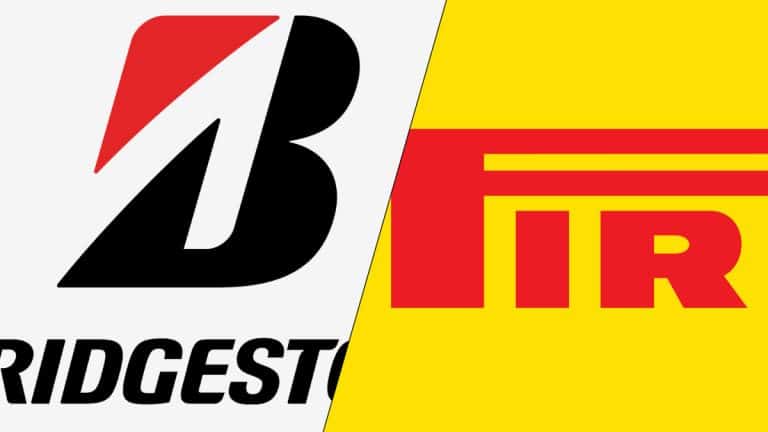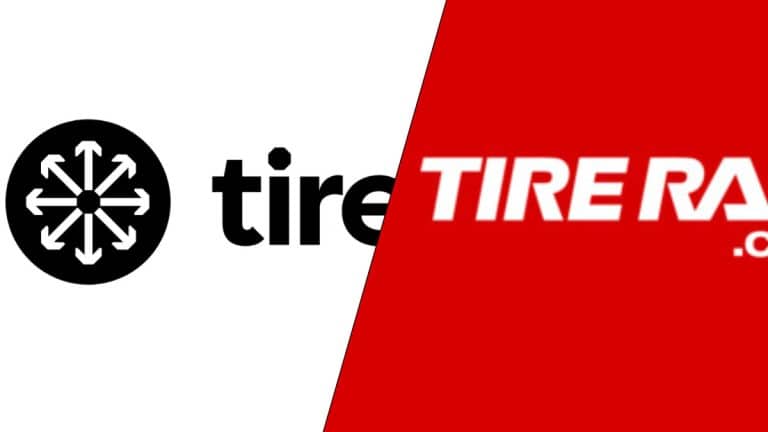Firestone Tires Review: A Solid Mid-Ranger
The tire industry has plenty of manufacturers for us car owners to choose from, which is a positive thing. They are spread into multiple categories depending on the price point and the performance. A common option we see rising in popularity is mid-range companies.
With these options, you’re looking at more affordable models when compared with the premiums. With that said, you’ll also lose a bit on performance, so that is to be expected. A good mid-range brand balances things out. In other words, offer a competitive price without sacrificing performance too much.
One of the many prominent names in this section of the industry is Firestone. The company was founded in 1900 in Akron, Ohio, so we’re not looking at a newcomer in this segment. Throughout its history, the company has offered innovative solutions and took part in numerous racing series. The most popular one is the Indy 500.
Even though it started as a separate company, recent financial complications were the main reason Bridgestone purchased it. The company operates as an individual manufacturer, but it’s under the umbrella of the Japanese giant.
So, how good of a mid-ranger is Firestone, and can it compete with the rest of the pack?
Firestone Tires Review
Here are the best Firestone tires currently on the market:
#1. Firehawk Indy 500
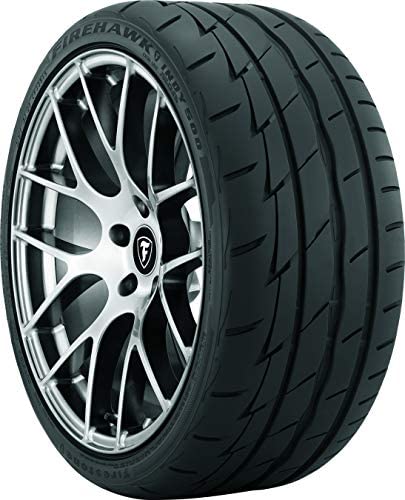
Price Check
Check the price of this tire at the following retailers:
Amazon DiscountTire PriorityTire SimpleTireDon't know the correct size tire to purchase? Start here!
The list starts with my favorite types of tires – performance ones. In this category, Firestone has the Firehawk Indy 500, a summer option aimed at maximum performance with the most dynamic handling.
Unlike some competitors, the Firehawk Indy 500 features a Long Link Carbon compound enriched with silica to help with traction in wet conditions. It’s molded into a pattern featuring wider grooves that should help evacuate water and offer improved aquaplaning resistance. For handling, the tire features wider and stiffer shoulder blocks that should help offer more responsive and precise handling.
On the road, this results in a tire with excellent performance. The Firehawk Indy 500 offers surprisingly high levels of grip and traction on dry roads. As a result, you can push it hard before it starts to let go. This comes with very short braking distances from a tire that will have no problem doing a track day. The tire continues to impress in wet conditions, thanks to its ability to offer plenty of performance. Thanks to the pulse groove technology, you’re also getting excellent aquaplaning resistance.
As a UHP tire, the refinement levels of the Firehawk Indy 500 are acceptable. The tire will offer a stiffer ride, meaning it won’t absorb all of the bumps, and you will feel some vibrations in the cabin. In terms of noise levels, it’s decent enough. It’s far from a touring tire, regardless if you’re driving around town or on the highway, but it’s not as loud as some of its rivals.
One of the main features of the Firehawk Indy 500 is the handling, and it doesn’t disappoint. The responsiveness is excellent, and you can place your car wherever you need to in the corner. You can make micro corrections with minimal movement from the steering wheel. The best part is that you’ll get plenty of feedback, so you’ll know what’s going on with the front tires. Unfortunately, there isn’t a treadwear warranty, something that the premium competitors offer.
Pros
- High levels of grip and traction on dry and wet roads
- Very dynamic
- Short braking distances
Cons
- Transfers a bit more vibrations into the cabin
- There isn’t a treadwear warranty
#2. Champion Fuel Fighter
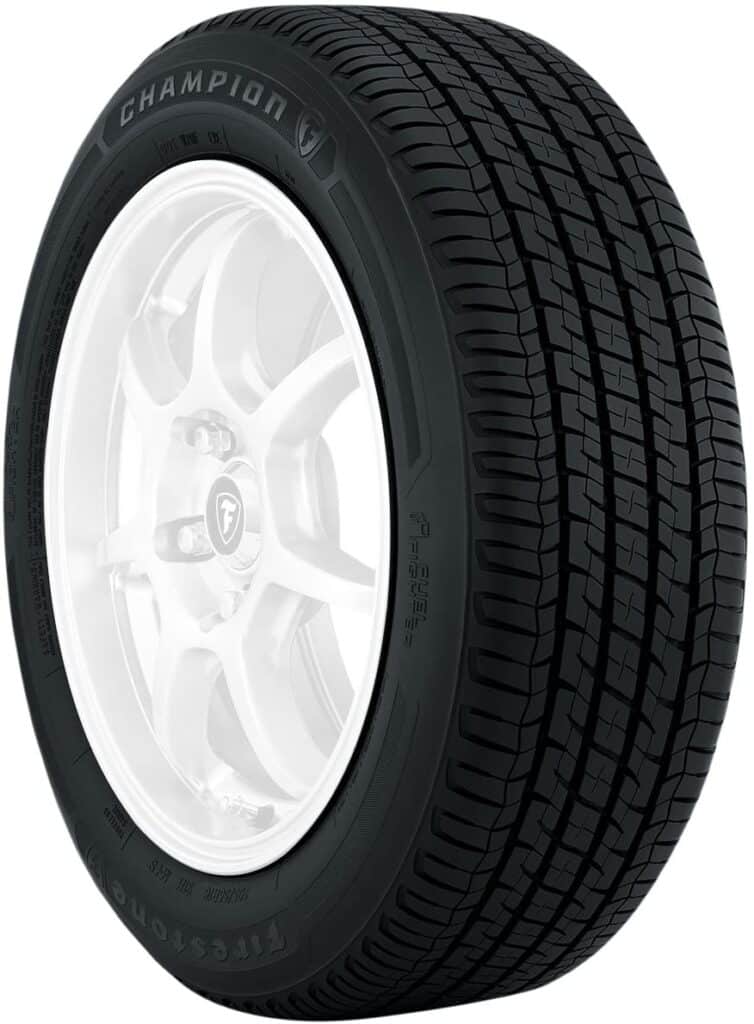
Price Check
Check the price of this tire at the following retailers:
Amazon DiscountTire PriorityTire SimpleTireDon't know the correct size tire to purchase? Start here!
On the opposite side of the spectrum, we have the Champion Fuel Fighter. This is Firestone’s touring model, designed for refinement, safe performance, and improved fuel consumption.
The Champion Fuel Fighter is an all-season model, meaning that Firestone used a silica-enhanced rubber compound which should provide performance in colder temperatures. It’s molded into a symmetric pattern that should offer lower noise levels and flexibility with rotation. To help with aquaplaning resistance, the tire features 4 circumferential grooves to help evacuate water efficiently.
In dry conditions, the Champion Fuel Fighter is a solid performer. The tire will offer plenty of grip and traction for daily driving, which should be enough for most people. This is backed by the short braking distances, making this a safe performer. Unfortunately, things aren’t as impressive in wet conditions. The tire is safe enough, and the performance is there, but I’d put it somewhere above average in this category. Things don’t improve much in winter conditions. The tire is usable only in lighter conditions, and even then, it falls a bit behind its rivals. On packed snow, the traction is even more limited, so it wouldn’t be my first choice for driving in winter.
What the Champion Fuel Fighter lacks in performance makes up with refinement. The tire can offer solidly high comfort levels. It absorbs bumps and minimizes vibrations well, providing a smooth ride in most situations. The noise levels, on the other hand, are impressively low. It will remain inaudible around town, and you’ll hear a faint hum at highway speeds.
As a touring tire, the Champion Fuel Fighter surprised me a bit regarding handling. It’s pretty responsive to your inputs, which is rare in this category. The warranty is another aspect of the tire that’s impressive. With a 70,000-mile treadwear warranty, it’s on the same level as some of its premium rivals.
Pros
- Excellent dry performance
- Premium-like treadwear warranty
- High refinement levels
Cons
- Wet performance is a bit behind some of its rivals
- The traction on packed snow is a bit limited
#3. All-Season

Don't know the correct size tire to purchase? Start here!
Firestone’s weakest tire in terms of naming is the All-Season model. This is a touring tire, so you’d get dependable performance from a model designed for longevity and refinement.
To achieve all-season performance, Firestone used a rubber compound enriched with silica to keep the tire usable in colder temperatures. The tread pattern features deeper sipes to help the tire perform in snowy conditions. Combining those with the grooves means the All-Season should offer excellent aquaplaning resistance.
As a mid-range touring tire, the All-Season offers dependable performance in dry conditions. The grip and traction levels are enough for daily driving, and most people will be happy with it. It’s not as good in wet conditions, though. The tire is safe and offers solid performance levels, but it will start to understeer once you push it a bit. Braking distances in both conditions are solid for this category. Snow seems to be this tire’s biggest enemy. It deals with unpacked snow acceptably well but struggles with packed one a lot.
The performance may not be the best, but the All-Season makes up for that in terms of refinement. As an affordable tire, the ride quality is smooth, and the tire absorbs bumps without too many issues. The noise levels aren’t as good as its premium rivals, but the tire is quiet enough.
Dynamic handling isn’t something you should expect from a touring tire, but the All-Season doesn’t do too badly. It’s responsive enough for most people and easy to maneuver. The best part is that you’ll get good feedback through the steering wheel. With a treadwear warranty of 65,000 or 55,000 miles, you’re getting a lot for the money.
Pros
- Very good dry performance
- Excellent refinement
- Long treadwear warranty
Cons
- Average snow performance
- The tire could use a bit more traction on damp roads
#4. Firehawk AS
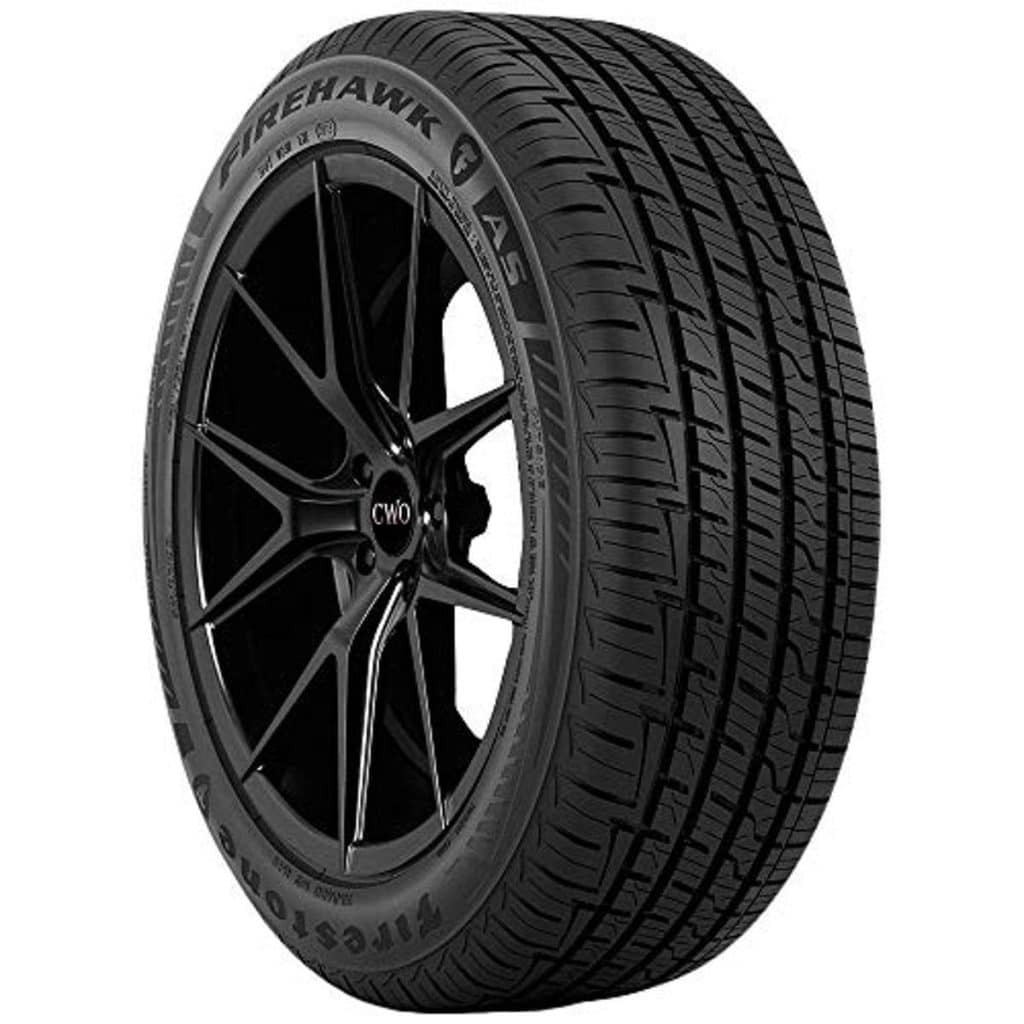
Price Check
Check the price of this tire at the following retailers:
Amazon DiscountTire PriorityTire SimpleTireDon't know the correct size tire to purchase? Start here!
Going back to the performance models, we have the Firehawk AS. Unlike the Indy 500, this one isn’t so focused on performance. Instead, Firestone aims to offer a blend of good performance and refinement.
Firestone went with a Long Link Carbon compound for the Firehawk AS to offer improved performance and durability over the previous model. As an all-season model, the tire features more biting edges to help it with snow traction. For harsh rain, the increased channels should help offer better aquaplaning resistance.
In dry conditions, the Firehawk AS offers solid performance. There’s plenty of grip for going around a corner and having some fun. The traction levels are also good, and the braking distances are short. It’s not on the same levels as the premium options, but it’s good for most people. Wet performance is excellent, thanks to the high levels of grip and traction on damp surfaces. The increased channels help evacuate water, offering excellent aquaplaning resistance. In winter, the performance is average. There is usable traction on snow, but nothing to write home about.
Despite the performance features, the Firehawk AS doesn’t do a poor job in terms of refinement. It does a very good job of softening bumps and offers a smooth riding experience. The noise levels are also on the lower end of the spectrum in this class, even when compared with some of the premium models.
Performance tires should offer dynamic handling, but the Firehawk AS isn’t the best. The tire is decently responsive and transfers some of the feedback through the steering wheel. In this regard, it’s comparable with some grand touring options. Firestone offers the tire with a 50,000-mile treadwear warranty, which is a positive side.
Pros
- Quiet and comfortable
- Wet performance is excellent
- Very good price-per-performance ratio
Cons
- Snow performance is limited
- Not the most dynamically inclined performance tire
#5. Destination LE3
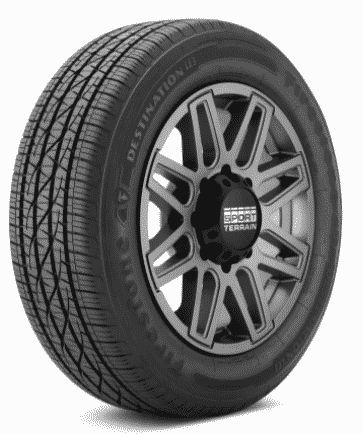
Price Check
Check the price of this tire at the following retailers:
Amazon DiscountTire PriorityTire SimpleTireDon't know the correct size tire to purchase? Start here!
From the CUV and SUV lineup, we have the latest addition to the Destination family – the LE3. This is an all-season highway tire, so it’s aimed at longevity and refinement.
To offer consistent wear and a long lifespan, Firestone utilized its TractionTech Technology. The Hydro-Grip technology is used for the tread pattern, which should offer excellent aquaplaning resistance. For winter conditions, the Destination LE3 is designed with full-depth 3D sipes that should help with traction on snow or damp roads.
Considering its category, the Destination LE3 offers excellent dry performance. With the levels of grip and traction, it’s easily comparable with the premium competitors. The impressive performance continues in wet conditions. You’ll have premium-like grip and traction levels on damp roads. The pattern with open shoulders also does a superb job of providing excellent aquaplaning resistance. As an all-season tire, this one offers very good snow performance. It deals with light snow easily, struggling only when you start to push it.
As a highway tire, the refinement is very good. The Destination LE3 deals with bumps like a champ, softening the blows and providing a smooth ride. Repetitive bumps and imperfections unsettle it a bit, but it’s not terrible. The noise levels are also very low, making this a quiet tire even at highway speeds.
The handling isn’t something that will get enthusiast existed, but it will be fine for most people. It’s easy to handle and won’t surprise you when you reach the limit. The Destination LE3 comes with a 70,000-mile treadwear warranty, which is pretty close to the top.
Pros
- Excellent refinement levels
- Superb dry and wet performance
- Traction on snow is pretty good for an all-season model
Cons
- No LT-metric models
- Repetitive road bumps can unsettle it a bit
#6. WeatherGrip
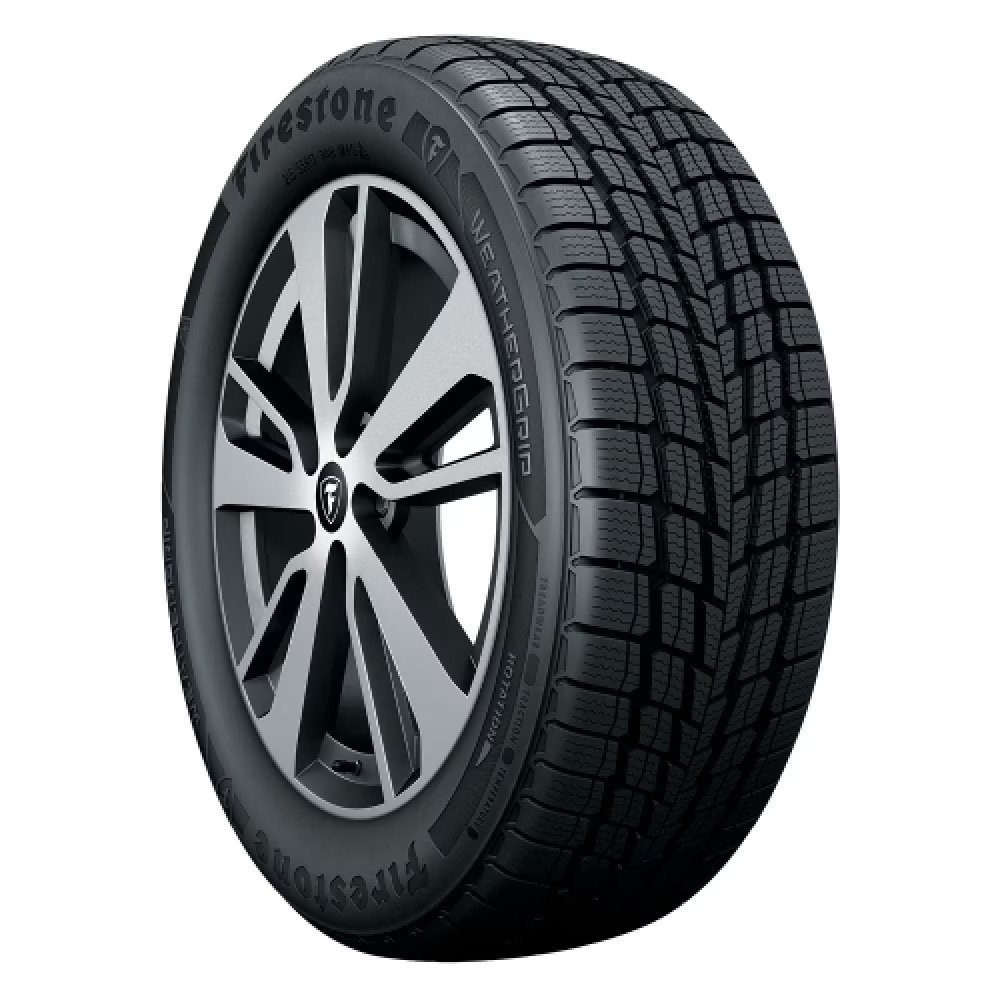
Price Check
Check the price of this tire at the following retailers:
Amazon DiscountTire PriorityTire SimpleTireDon't know the correct size tire to purchase? Start here!
Going back to the hatchbacks, sedans, and minivans, we have the WeatherGrip. Firestone advertises it as technically an all-weather tire, so we should see decent winter performance.
The all-season compound of the WeatherGrip is molded into a pattern featuring open shoulder slots. They should help with water evacuation and offer excellent aquaplaning resistance. As part of the design, we have full-depth 3D sipes. They work with the Snow Traction Claw technology to improve snow performance.
As a touring option, the WeatherGrip provides superb dry performance. It won’t struggle with traction even in aggressive scenarios, and the grip will be more than enough for daily driving. Things remain similar in wet, with the tire offering adequate performance for most people. The braking distances are a bit longer, but the aquaplaning resistance is superb. As a tire with a 3PMSF rating, you get a lot of winter performance. The tire will offer traction on packed, unpacked snow and even be usable on ice.
In terms of refinement, there are two sides to the WeatherGrip. The comfort levels are pretty good. You’ll get a generally smooth ride with the occasional jolt from larger potholes. The aggressive pattern doesn’t do any favors in terms of noise, though. It’s not the loudest tire around town, but that changes on the highway. I wouldn’t call it obnoxious, but it’s more noticeable than some of its rivals.
The WeatherGrip isn’t a performance tire, so the handling won’t be the best. It’s not the fastest to respond, and you struggle to figure out what the front tires are doing. The tire comes with a 65,000-mile treadwear warranty, which is more than some premium models.
Pros
- Snow performance is super considering its category
- Dry performance is very good
- Excellent aquaplaning resistance
Cons
- A bit noisier than some of its competitors
- Slightly longer braking distances
#7. Winterforce 2
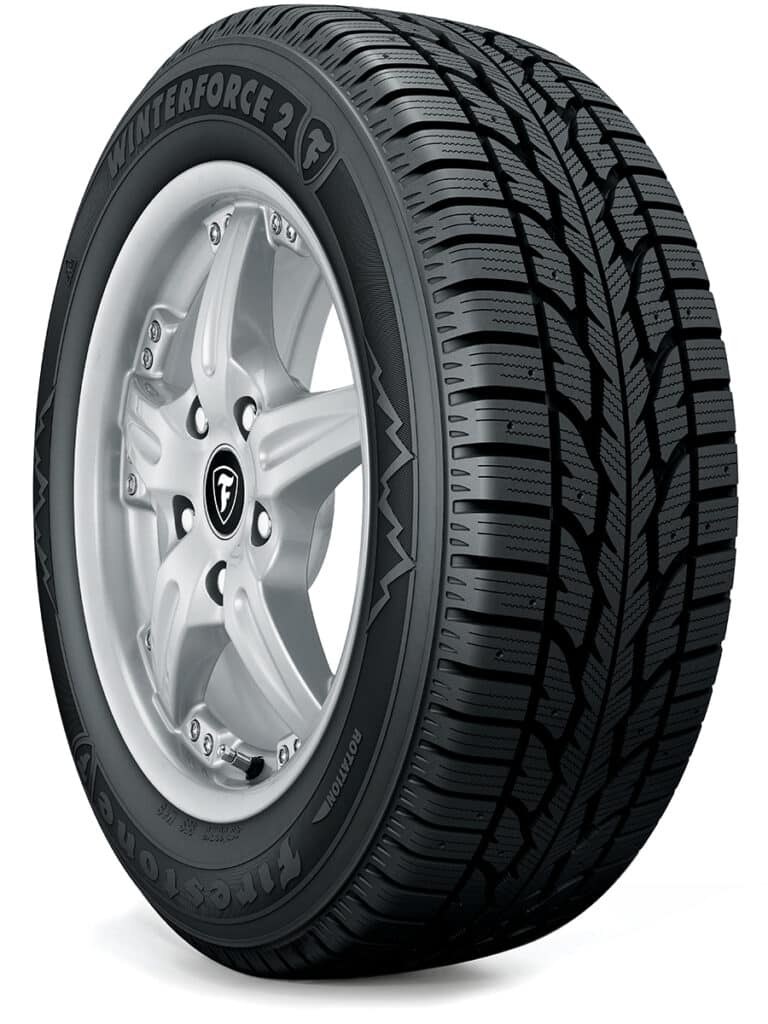
Price Check
Check the price of this tire at the following retailers:
Amazon DiscountTire PriorityTire SimpleTireDon't know the correct size tire to purchase? Start here!
What if you’re looking for the best winter performance? This is where the Winterforce 2 comes into play. It’s a studdable winter tire, meaning you should get the best possible performance in chilly conditions.
Firestone went with a winter-oriented compound molded into a directional pattern with full-depth grooves. This means the tire should be pliable in colder temperatures and provide excellent traction in snow. The high-density sipe design aims to offer better traction on packed snow and damp roads.
Within the mid-range segment, the Winterforce 2 offers good performance in dry conditions. The grip and traction levels are enough for daily driving as long as you don’t start to push it too much. On damp roads, the sipes are doing an excellent job at providing traction and keeping the tire planted. The design evacuates water efficiently, so the aquaplaning resistance is excellent. This gets backed by the short braking distances, so we are looking at a safe tire.
In lighter conditions, the Winterforce 2 offers superb performance, especially compared to the rest of the tires on this list. Regardless if we’re talking about packed or unpacked snow, the traction is there, and the tire won’t struggle. Getting too aggressive will get it to slip, but it’s not something most people will experience. The performance on ice is usable in a pinch. If you need more, you can get that once you fit the studs.
Despite the softer nature of the Winterforce 2, the tire isn’t the most comfortable one. It will deal with bumps acceptably well, but you’ll notice a jolt and some vibrations in the cabin. The noise levels also aren’t impressive. Like most winter tires, it won’t be the quietest option, especially on rougher surfaces or highway speeds.
Winter tires suffer in the handling department, and the Winterforce 2 is no different. The tire’s responsiveness is average at best, so most people won’t be tempted to push it. Despite its easy-to-handle nature, you won’t have a lot of feedback to inform you about the front tires.
Pros
- Excellent snow performance
- Superb aquaplaning resistance
- Studdable for extra traction on ice
Cons
- Average noise levels
- There is a noticeable jolt with larger bumps
#8. Destination A/T2
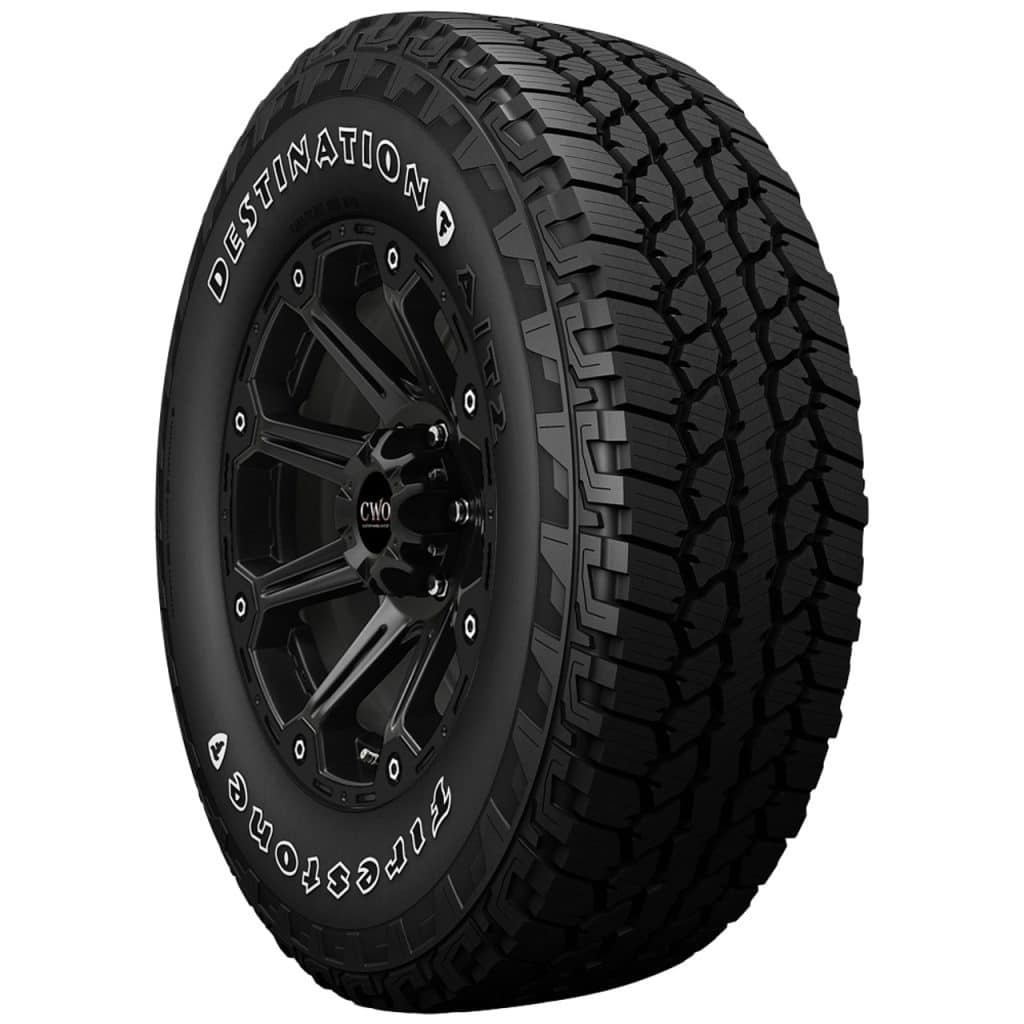
Price Check
Check the price of this tire at the following retailers:
Amazon DiscountTire PriorityTire SimpleTireDon't know the correct size tire to purchase? Start here!
The first off-road capable tire on this list is the Destination A/T2. This is an all-terrain option, meaning you’d get a blend of on- and off-road performance.
Like the previous model, the Destination A/T2 features an all-season compound capable of delivering some performance in winter. The pattern is designed to bite in and offer traction in snowy conditions. As part of the design, the wider channels should help evacuate more water, thus improving aquaplaning resistance.
In dry conditions, the Destination A/T2 offers surprisingly high levels of performance. The grip and traction will keep the tire planted even in some situations that most people won’t find themselves in. Things remain impressive in wet conditions. The tire offers plenty of traction and short braking distances on damp roads. As part of the package, you’re also getting excellent aquaplaning resistance. The 3PMSF rating of the tire shows through the solid snow performance. It won’t struggle as much as some of its competitors, and most people will be happy with the performance.
Off-roading is where the Destination A/T2 isn’t as impressive. You can use it in lighter conditions like dirt roads or shallow mud and get good performance out of it. With that said, you’ll need some of the “bigger” models from Firestone’s lineup for harsher conditions.
Despite being an off-road capable tire, the Destination A/T2 is still oriented more toward road use, so the refinement isn’t terrible. The comfort levels are solid, and the tire can absorb a good amount of bumps and imperfections. As for the noise levels, they aren’t the lowers in the all-terrain segment, so I’d put them as acceptably low.
All-terrain tires aren’t superb for handling, so the Destination A/T2 is no different. The tire may be fine for average drivers, but the lack of responsiveness and muted feedback will disappoint enthusiasts. With this model, you’re getting a 55,000-mile treadwear warranty, which is pretty good considering the category.
Pros
- Solid performance on snow
- Excellent dry and wet performance
- Long treadwear warranty
Cons
- No LT-metric models
- The off-road performance is average for this category
#9. Destination X/T
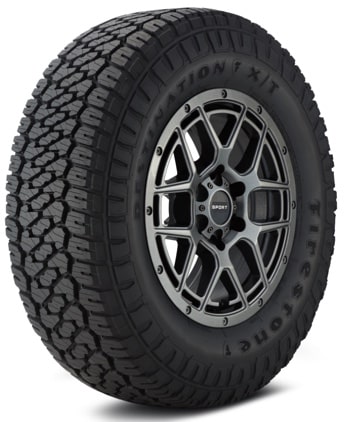
Price Check
Check the price of this tire at the following retailers:
Amazon DiscountTire PriorityTire SimpleTireDon't know the correct size tire to purchase? Start here!
In cases where the off-road performance isn’t enough, Firestone has the Destination X/T. This is a hybrid between an all-terrain and a mud-terrain tire, so we should see better off-road performance.
The all-season compound of the Destination X/T is molded into a more aggressive pattern which should help with snow and mud performance. Firestone went with an open shoulder block design to help better evacuate water. The staggered shoulder blocks are designed to provide improved performance in off-road scenarios.
Despite the off-road capabilities, the Destination X/T is a solid dry performer. There are enough grip and traction levels for everyday driving, and the tire won’t struggle too much in aggressive scenarios. Wet is another situation where the tire will deliver decent performance. The traction on damp surfaces will remain sufficient for most situations, and the braking distances will remain short. With this, you’re also getting excellent aquaplaning resistance. The performance on snow is good enough, and the tire will deal well with packed and unpacked snow. There is a point where the snow is too deep, but that’s in situations where you’d need a winter tire.
Unlike the previous model, the Destination X/T does much better in off-road conditions. It will have no issues with dirt roads or mud. Even if the mud is deeper, the tire will offer solid traction, which should be enough for most people. It won’t do the best job in rock-crawling situations, which is where the next tire comes into play.
The refinement is more or less similar to most of the all-terrain-like models. With the Destination X/T, you get a decently comfortable ride, as the tire can absorb some of the bumps and vibrations. The LT-metric tires are just a bit harsher, but it’s not a terrible experience. Noise levels aren’t as great. Like most of its rivals, the aggressive pattern will produce more noise.
As for handling, the Destination X/T is decently responsive for an off-road capable tire. It’s not a UHP model, so it won’t do a marvelous job at it. You also won’t have a lot of feedback to rely on. The tire comes with a 50,000-mile treadwear warranty, which is much better than some of its rivals that don’t have one at all.
Pros
- Excellent off-road performance
- Solid performance on paved roads
- Decently comfortable
Cons
- Poor ice traction
- Noise levels aren’t so great
#10. Destination M/T2
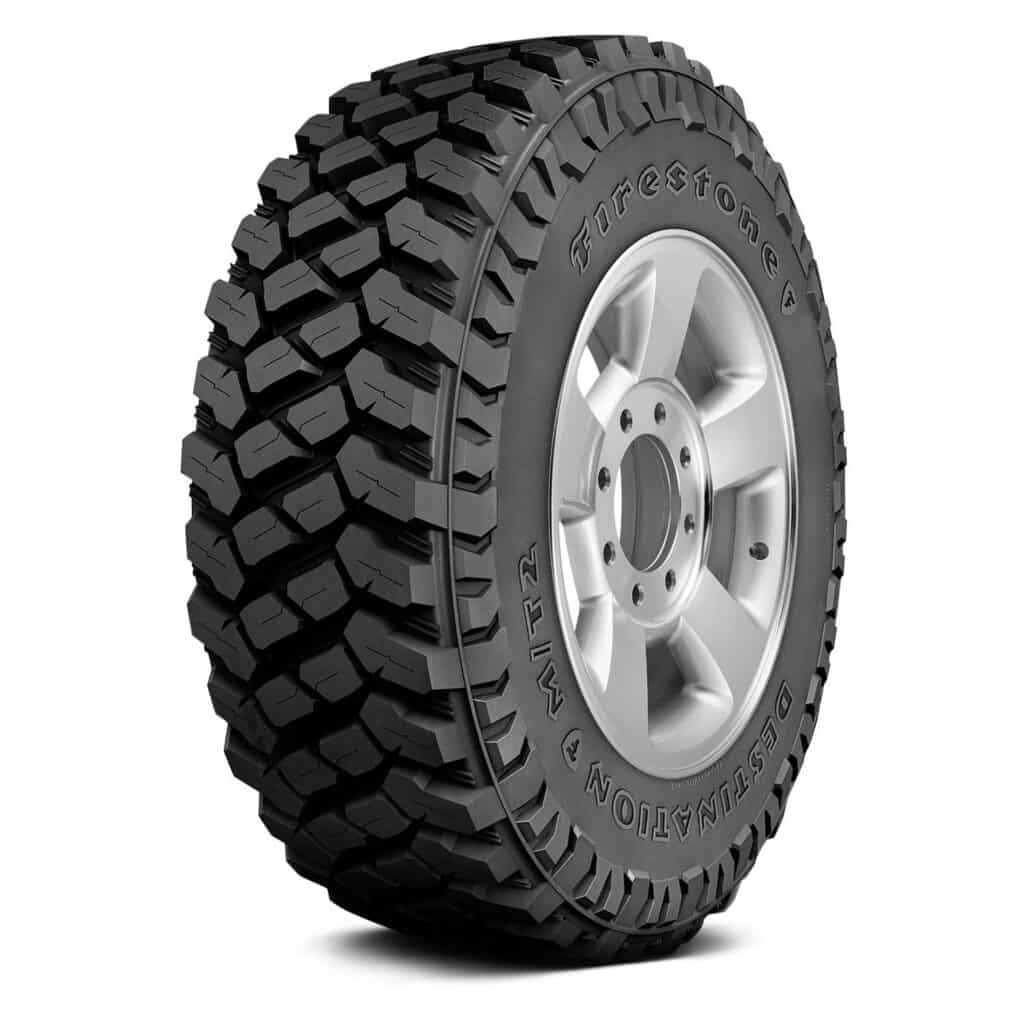
Price Check
Check the price of this tire at the following retailers:
Amazon DiscountTire PriorityTire SimpleTireDon't know the correct size tire to purchase? Start here!
For the best possible off-road performance, you have the Destination M/T2. This is a proper mud-terrain tire that delivers the best performance in these conditions without too many compromises.
Firestone upgraded its compound, which, combined with the more aggressive upper lugs, should offer more durability and make it cut and chip resistant. For off-roading scenarios, the Destination M/T2 features a stone rejector design that should help with consistent performance. The increased number of biting edges means we should see improved performance in multiple conditions.
On the road, the Destination M/T2 delivers average performance. In dry conditions, the tire’s grip and traction levels are acceptable but behind some of its rivals. Things don’t improve much on wet roads, and the tire isn’t one that you can push. The traction levels are acceptable if you’re careful, and the same can be said about the grip. One positive thing is the solid aquaplaning resistance, even on the highway. On unpacked snow, the pattern does an excellent job of offering excellent traction. Packed snow can be problematic, and the tire will struggle a bit more. Ice is where the tire falls apart, which is to be expected from a mud-terrain tire.
In off-road conditions, there aren’t too many situations where the Destination M/T2 will struggle. Hard-packed surfaces like dirt roads pose no problem, and the tire will deliver more than enough performance. Driving on mud also isn’t an issue, and the traction will remain excellent even in deeper situations. Rock-crawling is what mud-terrain tires are known for, and this one won’t disappoint at all.
The refinement of the Destination M/T2 is a mixed bag, which is the case with most mud-terrain tires. On the comfort side, the tire will do a decent job of softening imperfections and smaller potholes. Noise levels are as you’d expect. The tire’s growl is noticeable even at lower speeds and increases as you get on the highway.
Surprisingly, the handling isn’t as poor as I thought. The Destination M/T2 offers a well-responsive nature for a tire from this category. It’s stable on the highway, and the tracking is pretty decent.
Pros
- Marvelous off-road performance in all conditions
- Decent handling characteristics considering the category
- Comfortable enough
Cons
- Average performance on the road
- Noise levels are slightly higher than its rivals
Firestone Tires Buying Guide
What is there to like about Firestone tires? What is it that distinguishes these tires from the chasing pack? Are there areas where Firestone tires could or should have done better? Any shortcomings that could potentially be deal-breakers? This section has all the answers.
Why Should You Buy Firestone Tires?
Here’s why Firestone tires should be on your short list of tire brands to buy next:
1. Affordable
We can praise the premium tires as much as we want, but going for an expensive tire isn’t something all car owners can afford. This is why mid-range manufacturers exist. Firestone is one of them, so it can offer a competitive price when you compare it to the expensive manufacturers. It doesn’t come without some sacrifices, which brings me to the second reason why you should buy Firestone tires.
2. Solid performance
I won’t say excellent because that’s reserved for the premium tires. With mid-range models like Firestone, you’re getting solid performance, which is what you should expect when paying a lower price. To be fair, there are situations where even these tires can come close to the premium ones, which is good news for people that don’t want to spend top dollar.
3. Long treadwear warranty
Having a long-lasting tire is something that most of us want. Firestone is one of the several brands that can offer that. The treadwear warranty, at least the models with one, is on the same level as the premium manufacturers, or even better. Combining this with the affordable price tag makes these tires an affordable bargain.
Why Should You NOT Buy Firestone Tires?
Here’s why Firestone tires may not be a good choice for you:
1. Average noise levels
This doesn’t apply to all models in Firestone’s lineup, but many suffer from this. The noise levels aren’t the lowest you’ll find, even when compared with some of its mid-range rivals. Don’t get me wrong, these are far from the loudest tires, but I wouldn’t start comparing them with the quietest ones.
2. Limited LT-Metric Models
At first glance, Firestone seems to cover the larger vehicles quite nicely. With that said, it doesn’t do a very good job of covering the largest vehicles. If you’re an SUV or a light truck owner, you’ll be fine, but the number of options for heavy-duty trucks is limited. This is because this manufacturer doesn’t have a lot of LT-metric sizes for all of its models, which can be a limiting factor for some people.
Frequently Asked Questions
Here are some of the common queries people have about Firestone tires:
Who makes Firestone tires?
Firestone has been around for well over a century, making its own tires. That changed a few decades ago when Bridgestone purchased it, but despite that, the company continued running independently, making its own tires.
Where are Firestone tires made?
Even though Firestone is a domestic brand, the company branched out, leading us to tires made in multiple countries. Despite the manufacturing plants in the US, this manufacturer produces tires in Canada and a few countries in South America. With that said, it also utilizes some of Bridestone’s plants whenever needed.
How long do Firestone tires last?
Multiple factors determine a tire’s longevity. The one we usually look at is the treadwear warranty, something that Firestone does very well. Within the mid-range segment, the tires offer high mileage numbers in terms of warranty. Compared with the premium models, we see numbers on the same level or, in some cases, higher. Combining this with numerous reports from owners leads me to think these are decently long-lasting tires.
Is Firestone a good brand?
Whenever we talk about mid-range brands, we cannot categorize them as the best, and the same goes for Firestone. In my opinion, we’re looking at a good brand with some slight drawbacks. This is expected, mainly because with the lower price point, you’ll have to live with a few compromises.
Are Firestone tires noisy?
One thing that some Firestone models suffer from is noise levels. They aren’t the highest in the mid-range segment but are more audible than some rivals. To be fair, this is one of the tradeoffs you get when going for a more affordable brand. If you have a vehicle with good sound insulation, this shouldn’t be a massive issue. Also, it’s important to note that not all models from this brand are noisier.
Are Firestone tires good for snow?
Snow performance is something that Firestone tires do decently well in most cases. With most of the all-season models, you’ll get usable performance, which will be fine if you live in an area with mild winters. For harsher conditions, the studdable winter model does a phenomenal job tackling those conditions, so you won’t have any issues.
Conclusion
When we talk about mid-range manufacturers, we must set our expectations right. They aren’t as good as the premium models, which is to be expected considering the lower price point. It’s the same with Firestone.
The company makes very good tires that deliver solid performance in most conditions. Naturally, there are some situations where they don’t do so well or are a bit noisier than some of their competitors. The lower price point doesn’t seem to affect the longevity, as the treadwear warranty of most tires is close to or better than some premium models.
In general, Firestone isn’t a brand that you should avoid. Naturally, the premium manufacturers offer better tires, but they also cost more. With this one, you’re paying less, so if you’re prepared for a few slight drawbacks, Firestone can be an excellent choice for you.

